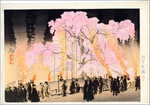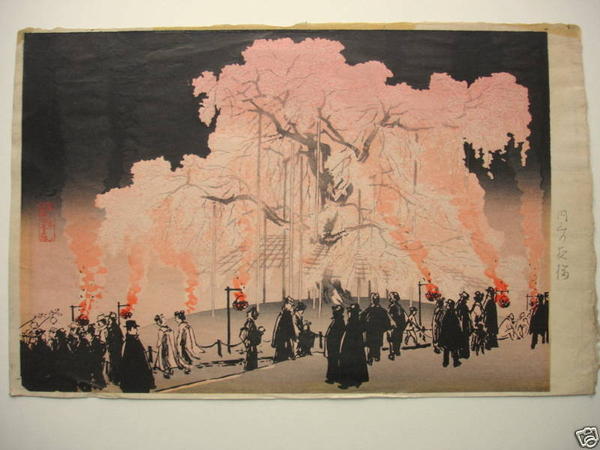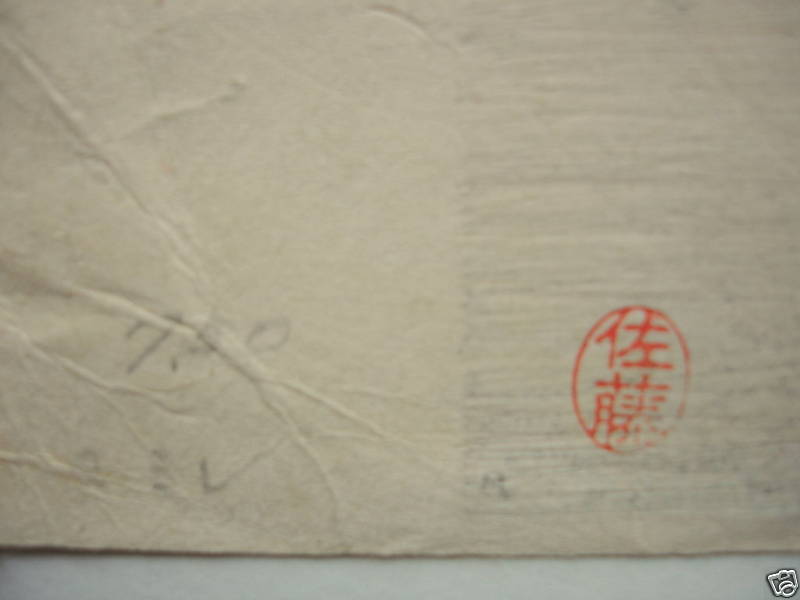| | |
| Artist: | Kanpo Yoshikawa (1894-1979) — 吉川観方 |
| Title: | Cherry Blossoms at Night- Maruyama Park |
| Series: | |
| Date of first edition?: | 1925 |
| Publisher (first edition)?: | Sato Shotaro |
| Publisher (this edition)?: | Sato Shotaro |
| Medium (first edition): | Woodblock |
| Medium (this edition): | Woodblock |
| Format (first edition): | Large Oban
|
| Format (this edition): | Large Oban |
| DB artwork code: | 41312 |
| Notes (first edition)?: |
|
| Notes (this edition)?: |
| The following information was taken from the original web listing of this artwork. Note that there may be some inaccuracies:
Sunday, 21 September 2008
This is the same as item Full1.
Artist: Yoshikawa Kanpo (1894-1979)
Signature: artist signature and with red seal
Title: Cherry Blossom at Nightin Maruayamapark (Kyoto)
Date: c. 1925
Publisher: Sato Shotaro (c. 1895-1931). It is known that the carver of this print was Maeda and the Printer was Oiwa.
Medium: Woodblock printing
Size: Image: 10 3/5" x 15 3/5 '' ( 26,5 x 39,0 cm) . Total size approximately: 11 " x 17 1/5 " ( 27,5 x 43 cm) (Dai Oban)
Impression: Very Good
Condition/Colour: Fair.
The print has been framed in the past, that's why there is some toning down of the colour, see along the margins for the difference, (caused by exposure to daylight of the print), and there is brown residu (from the framing) along the upper margin and partial for 1 a 2 millimetre in the image.
Some wrinkles in margins,a small crease ( left corner below ). A red seal on reverse (publisher/edition/collector?). Clean on reverse (exclusive upper margin and pencilmarks). Shiny black lacquer colour . Seldom seen and offered on the market and it is a famous classic Shin Hanga print.
Description: A night scene with passers-by, some in western clothing, near a by ' braziers' light up cherry tree.This is a very famous Cherry tree from the 19th century, it still exist. In 2005 I saw this tree in the Maruyama Park in Kyoto.
|
|
| Artist Bio: |
Yoshikawa Kanpo (1894-1979) was born in Kyoto with the name Kenjiro. In 1901, he began studying Japanese-style painting under Nishibori Tosui. Kanpo also studied under the well-known artist Takeuchi Seiho (1864-1944). He entered the Kyoto Specialist School of Painting in 1914, graduating four years later. After this, Kanpo worked as an advisor on design for the Shochiku Theater company in Kyoto. Around 1922 to 1924, Kanpo worked with the Kyoto publisher Sato Shotaro on a small series of woodblock prints. These included several prints of actors, as well as a few Kyoto landscapes and bijin prints. Kanpo is significant as being one of the first Kyoto artists to produce shin hanga actor prints. His portraits are particularly unique for their rounded stylized features and muted colors. These portraits are reflective of kabuki theater in the Kamigata region (Kyoto and Osaka) where the wagoto style of acting was popular. The wagoto style was more refined and gentle, well-suited to romantic plays and realistic dramas. Actors in this style wore understated clothing and makeup. Wagoto was in sharp contrast to the highly dramatic aragato style, or rough acting, popular in Tokyo kabuki, and depicted by artists like Tadamasa Ueno. Kanpo's prints were carved by Kentaro Maeda and printed by Oiwa in limited editions of 100 or 200. Some of his designs were reprinted in a later unnumbered edition. In 1925, he exhibited prints with Miki Suizan, another artist who was published by Sato Shotaro. Both of their works were included in the Toledo Museum exhibition of 1930. After 1925, Kanpo made no other woodblock prints and produced paintings only on commission. He remained passionately interested in the Japanese kabuki theater, particuarly in its history, costumes, and traditional music. During his life, Kanpo wrote several books related to Kabuki and Japanese prints, including "Faces in Color Prints", "Contemporary Actors on the Stage", "Mirrors and Designs", "History of Changes in Sash Design", and "History of Japanese Folk Customs".
|
|












